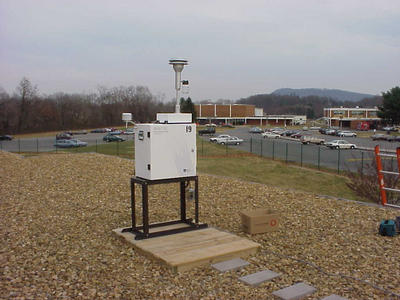
The American Lung Association’s “State of the Air 2015” report finds the 2-city, 4-county Roanoke metropolitan area improved its performance for two of the three measures of air pollution, the report tracks ground-level ozone (smog) and long-term (year-round) fine particle pollution.
According to the 2015 report, based on data for the three-year period of 2011-2013, Roanoke showed improvements in daily maximum 8-hour average ozone levels, its weighted average improving from 0.7 days of unhealthy air quality in the previous report to 0.3 days, but still earning a grade of “B.” The metro area’s rank for this measure improved from 155th to 163rd worst in the nation.
For fine particle pollution, the metro area improved in its year-round measure of this pollutant, again earning a passing mark by beating the national standard of 12.0 micrograms per cubic meter. In addition to Roanoke City having incomplete data for this year’s report, the long-term average in Salem City changed from 9.7 to 9.1, consistent with a trend seen across the nation of lower particle pollution levels.
Since some areas of the country had to be omitted from the report because of data quality problems, and other metro areas continued to improve, the metro area’s rank for year-round particle pollution remained unchanged at 103rd worst in the United States.
As in last year’s report, there were zero days with unhealthy levels of fine particle pollution in both Roanoke City and Salem City. Therefore they were listed among the cleanest counties in the country for earning perfect “A” grades, and the Roanoke metro area was listed among the cleanest cities nationally. Unfortunately, for the same problems cited, the metro area’s rank worsened significantly from 142nd to 98th worst in the nation.
Nationwide, more than 4 in 10 Americans – nearly 138.5 million people – live in counties where ozone or particle pollution levels make the air unhealthy to breathe, according to “State of the Air 2015.” The 16th annual national report card, which looks at air pollution data collected from 2011-2013, shows that improvement in the nation’s air quality was mixed, with many cities experiencing strong improvements, while others suffered increased episodes of unhealthy air, and a few even marked their worst number of unhealthy days.
“The Roanoke metropolitan area can certainly be proud of the progress we’ve made in cleaning up our air since the first ‘State of the Air’ report 16 years ago. However, there’s still a lot of work to be done to make our air healthy for all Virginians to breathe,” said Deborah Brown, President and CEO of the American Lung Association of the Mid-Atlantic.
“We can thank cleaner diesel fleets and cleaner power plants for contributing to some air pollution reductions. However, localized episodes of poor air quality continue to be a struggle for those who live, work and visit the metro area, especially for those with lung disease, like asthma or COPD,” said Brown. “Reducing pollution will only become more challenging because warmer temperatures increase the risk for ozone and particle pollution, and make cleaning up the air harder in the future. We need stronger air quality standards to limit pollution and continued cleanup of the current sources of pollution in the Roanoke area to protect the health of our citizens.”
Particle pollution levels can spike dangerously for hours to weeks on end (short-term) or remain at unhealthy levels on average every day (year-round). Particle pollution can penetrate deep into the lungs and even into the bloodstream, leading to premature deaths, asthma attacks and heart attacks, as well as lung cancer.
Ozone is the most widespread air pollutant, created by the reaction of sunlight on emissions from vehicles, industry, power plants and other sources. When ozone is inhaled, it irritates the lungs, like a bad sunburn. It can cause health problems that are immediate and some that can appear days later. Ozone can cause wheezing, coughing, asthma attacks and premature death.
To see how your community ranks in “State of the Air 2015,” to learn how to protect yourself and your family from air pollution, and to join the fight for healthy air, visit: www.StateOfTheAir.org.
.


